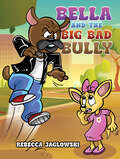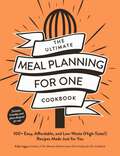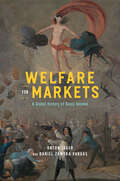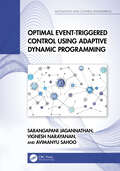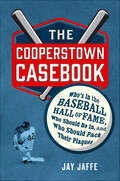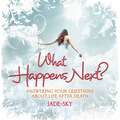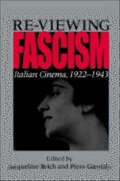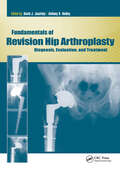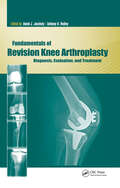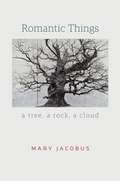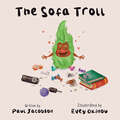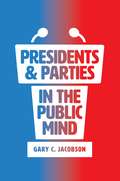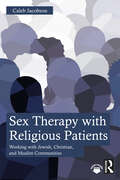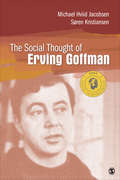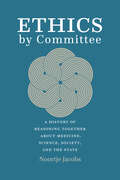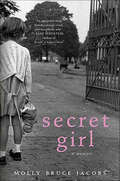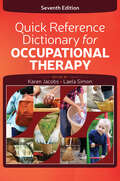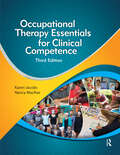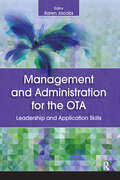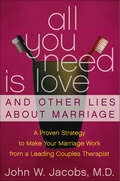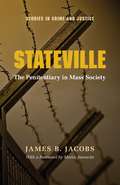- Table View
- List View
Bella and the Big Bad Bully
by Rebecca JaglowskiIt doesn&’t matter how big or small you may be, anyone can save the day and be a superhero.Bella, a small, spunky Chihuahua, feels as if she can&’t do as much as the rest of her pals because of her size.Her pals always made her feel accepted – that is, until the town bully comes by. Ty, a bulldog who is much larger than the rest and wears a shiny chain around his neck, stirs up trouble with Bella and her pals.It isn&’t until Ty and the rest of the gang is in trouble and desperately need Bella&’s help that he realizes he shouldn&’t bully others because of their size or shape.
The Ultimate Meal Planning for One Cookbook: 100+ Easy, Affordable, and Low-Waste (High-Taste!) Recipes Made Just for You (Ultimate for One Cookbooks Series)
by Kelly JaggersPlan your weekly meals while saving time and money with these 100+ recipes perfect for every solo chef trying to build a delicious, cost-effective, low-waste meal plan.Meal planning for one can feel daunting…especially if you want to avoid tons of leftovers and food waste while still making delicious single-serving meals. The good news is that The Ultimate Meal Planning for One Cookbook is here to help with easy-to-use meal plans and over 100 recipes that are designed for meal planning for one. This book allows you to make over 100 delicious, one-to-two-serving recipes for every meal from breakfast to dinner and everything in between. And, not only will you find tasty recipes designed for one, you&’ll also learn to use them to design your own weekly meal plans. Learn how to avoid eating the same old leftovers over and over throughout the week, how to utilize your ingredients as much as possible so nothing goes to waste, and to enjoy delicious versions of your favorite dishes, no matter the occasion. Whether you live alone or are just searching for the perfect meal for yourself, cooking solo need never be boring (or repetitive and wasteful!) again.
Welfare for Markets: A Global History of Basic Income (The Life of Ideas)
by Anton JägerA sweeping intellectual history of the welfare state’s policy-in-waiting. The idea of a government paying its citizens to keep them out of poverty—now known as basic income—is hardly new. Often dated as far back as ancient Rome, basic income’s modern conception truly emerged in the late nineteenth century. Yet as one of today’s most controversial proposals, it draws supporters from across the political spectrum.In this eye-opening work, Anton Jäger and Daniel Zamora Vargas trace basic income from its rise in American and British policy debates following periods of economic tumult to its modern relationship with technopopulist figures in Silicon Valley. They chronicle how the idea first arose in the United States and Europe as a market-friendly alternative to the postwar welfare state and how interest in the policy has grown in the wake of the 2008 credit crisis and COVID-19 crash.An incisive, comprehensive history, Welfare for Markets tells the story of how a fringe idea conceived in economics seminars went global, revealing the most significant shift in political culture since the end of the Cold War.
Optimal Event-Triggered Control Using Adaptive Dynamic Programming (ISSN)
by Sarangapani Jagannathan Vignesh Narayanan Avimanyu SahooOptimal Event-triggered Control using Adaptive Dynamic Programming discusses event triggered controller design which includes optimal control and event sampling design for linear and nonlinear dynamic systems including networked control systems (NCS) when the system dynamics are both known and uncertain. The NCS are a first step to realize cyber-physical systems (CPS) or industry 4.0 vision. The authors apply several powerful modern control techniques to the design of event-triggered controllers and derive event-trigger condition and demonstrate closed-loop stability. Detailed derivations, rigorous stability proofs, computer simulation examples, and downloadable MATLAB® codes are included for each case.The book begins by providing background on linear and nonlinear systems, NCS, networked imperfections, distributed systems, adaptive dynamic programming and optimal control, stability theory, and optimal adaptive event-triggered controller design in continuous-time and discrete-time for linear, nonlinear and distributed systems. It lays the foundation for reinforcement learning-based optimal adaptive controller use for infinite horizons. The text then: Introduces event triggered control of linear and nonlinear systems, describing the design of adaptive controllers for them Presents neural network-based optimal adaptive control and game theoretic formulation of linear and nonlinear systems enclosed by a communication network Addresses the stochastic optimal control of linear and nonlinear NCS by using neuro dynamic programming Explores optimal adaptive design for nonlinear two-player zero-sum games under communication constraints to solve optimal policy and event trigger condition Treats an event-sampled distributed linear and nonlinear systems to minimize transmission of state and control signals within the feedback loop via the communication network Covers several examples along the way and provides applications of event triggered control of robot manipulators, UAV and distributed joint optimal network scheduling and control design for wireless NCS/CPS in order to realize industry 4.0 vision An ideal textbook for senior undergraduate students, graduate students, university researchers, and practicing engineers, Optimal Event Triggered Control Design using Adaptive Dynamic Programming instills a solid understanding of neural network-based optimal controllers under event-sampling and how to build them so as to attain CPS or Industry 4.0 vision.
Alternate Dispute Resolution Systems
by P. JaganathanThe Arbitration and Conciliation Act, 1996, aims to facilitate the resolution of disputes in international trade and commerce through streamlined and accessible means. It effectively promotes arbitration as a primary method of alternative dispute resolution, ensuring minimal court interference. By prioritizing efficiency and convenience, the Act provides a robust framework that supports the swift and fair settlement of commercial conflicts, aligning with global standards and enhancing the attractiveness of arbitration for international parties. This legislative approach underscores the commitment to fostering a favorable environment for international trade and commerce.
Family Law 1
by P. JaganathanThe subject of Family laws, especially Family Law 1 is exhaustive yet most applicable in every person's life. For clear understanding of the subject, the study material is presented in a coherent manner, in a simple style and in lucid language.
The Cooperstown Casebook: Who's in the Baseball Hall of Fame, Who Should Be In, and Who Should Pack Their Plaques
by Jay JaffeA revolutionary method for electing players to the Baseball Hall of Fame from Sports Illustrated writer Jay Jaffe, using his popular and proprietary “JAWS” ranking system.The National Baseball Hall of Fame and Museum, tucked away in upstate New York in a small town called Cooperstown, is far from any major media market or big league stadium. Yet no sports hall of fame’s membership is so hallowed, nor its qualifications so debated, nor its voting process so dissected. Since its founding in 1936, the Hall of Fame’s standards for election have been nebulous, and its selection processes arcane, resulting in confusion among voters, not to mention mistakes in who has been recognized and who has been bypassed. Numerous so-called “greats” have been inducted despite having not been so great, while popular but controversial players such as all-time home run leader Barry Bonds and all-time hits leader Pete Rose are on the outside looking in. Now, in The Cooperstown Casebook, Jay Jaffe shows us how to use his revolutionary ranking system to ensure the right players are recognized. The foundation of Jaffe’s approach is his JAWS system, an acronym for the Jaffe WAR Score, which he developed over a decade ago. Through JAWS, each candidate can be objectively compared on the basis of career and peak value to the players at his position who are already in the Hall of Fame. Because of its utility, JAWS has gained an increasing amount of exposure in recent years. Through his analysis, Jaffe shows why the Hall of Fame still matters and how it can remain relevant in the 21st century.
What Happens Next? (What Happens Next? Ser.)
by Jade-SkyHerbs can heal, comfort and nourish and they hold ancient energies that people have used throughout time to create magick spells. This same magickal power in nature is yours to explore with everyday sacred herbs so that you may also facilitate change and find the support and inspiration you are seeking. Along with 60 sacred herb spells from Cheralyn Darcey&’s personal nature grimoire, The Book of Herb Spells features spellcasting and spellcrafting basics, magickal gardening, supply sourcing and dedicated lessons on how to write and cast your own spells. To complete your treasury of herb nature magick, a beautifully illustrated personal grimoire journal section is provided to keep your own bespoke herbs spells.
Re-viewing Fascism: Italian Cinema, 1922–1943
by Jacqueline Reich and Piero GarofaloWhen Benito Mussolini proclaimed that "Cinema is the strongest weapon," he was telling only half the story. In reality, very few feature films during the Fascist period can be labeled as propaganda. Re-viewing Fascism considers the many films that failed as "weapons" in creating cultural consensus and instead came to reflect the complexities and contradictions of Fascist culture. The volume also examines the connection between cinema of the Fascist period and neorealism—ties that many scholars previously had denied in an attempt to view Fascism as an unfortunate deviation in Italian history. The postwar directors Luchino Visconti, Roberto Rossellini, and Vittorio de Sica all had important roots in the Fascist era, as did the Venice Film Festival. While government censorship loomed over Italian filmmaking, it did not prevent frank depictions of sexuality and representations of men and women that challenged official gender policies. Re-viewing Fascism brings together scholars from different cultural and disciplinary backgrounds as it offers an engaging and innovative look into Italian cinema, Fascist culture, and society.
Fundamentals of Revision Hip Arthroplasty: Diagnosis, Evaluation, and Treatment
by David Jacofsky Anthony HedleyFundamentals of Revision Hip Arthroplasty: Diagnosis, Evaluation, and Treatment is a unique and very timely book designed for surgeons who are beginning to more commonly encounter hip revisions in their practice. Unlike many traditional books on revision, Fundamentals of Revision Hip Arthroplasty does not focus on the most difficult and challenging of cases. Rather, Fundamentals of Revision Hip Arthroplasty is intended to guide the surgeon in the evaluation of the failed or painful total joint replacement, review basic tenants and surgical principles of revision arthroplasty, and guide the surgeon in determining whether a given case is one that should be managed or is best referred to a tertiary orthopedic center.Along with their 32 contributors, Dr. David J. Jacofsky and Dr. Anthony K. Hedley provide detailed information inside Fundamentals of Revision Hip Arthroplasty, including appropriate preoperative evaluation, equipment requirements, surgical planning, need for augments and allograft, and surgical techniques.Surgeons will be tackling hip revision surgery more frequently as the number of these cases is exponentially increasing. Fundamentals of Revision Hip Arthroplasty provides a “go-to” resource to turn to for guidance by community arthroplasty surgeons, arthroplasty fellows, and residents.
Fundamentals of Revision Knee Arthroplasty: Diagnosis, Evaluation, and Treatment
by David Jacofsky Anthony HedleyFundamentals of Revision Knee Arthroplasty: Diagnosis, Evaluation, and Treatment is a unique and very timely book designed for surgeons who are beginning to more commonly encounter knee revisions in their practice. Unlike many traditional books on revision, Fundamentals of Revision Knee Arthroplasty does not focus on the most difficult and challenging of cases. Rather, Fundamentals of Revision Knee Arthroplasty is intended to guide the surgeon in the evaluation of the failed or painful total joint replacement, review basic tenants and surgical principles of revision arthroplasty, and guide the surgeon in determining whether a given case is one that should be managed or is best referred to a tertiary orthopedic center.Along with their 32 contributors, Dr. David J. Jacofsky and Dr. Anthony K. Hedley provide detailed information inside Fundamentals of Revision Knee Arthroplasty, including appropriate preoperative evaluation, equipment requirements, surgical planning, need for augments and allograft, and surgical techniques.Surgeons will be tackling knee revision surgery more frequently as the number of these cases is exponentially increasing. Fundamentals of Revision Knee Arthroplasty provides a “go-to” resource to turn to for guidance by community arthroplasty surgeons, arthroplasty fellows, and residents.
Romantic Things: A Tree, A Rock, A Cloud
by Mary JacobusOur thoughts are shaped as much by what things make of us as by what we make of them. Lyric poetry is especially concerned with things and their relationship to thought, sense, and understanding. In Romantic Things, Mary Jacobus explores the world of objects and phenomena in nature as expressed in Romantic poetry alongside the theme of sentience and sensory deprivation in literature and art. Jacobus discusses objects and attributes that test our perceptions and preoccupy both Romantic poetry and modern philosophy. John Clare, John Constable, Rainer Maria Rilke, W. G. Sebald, and Gerhard Richter make appearances around the central figure of William Wordsworth as Jacobus explores trees, rocks, clouds, breath, sleep, deafness, and blindness in their work. While she thinks through these things, she is assisted by the writings of Maurice Merleau-Ponty, Jacques Derrida, and Jean-Luc Nancy. Helping us think more deeply about things that are at once visible and invisible, seen and unseen, felt and unfeeling, Romantic Things opens our eyes to what has been previously overlooked in lyric and Romantic poetry.
The Sofa Troll
by Paul JacobsonHave you ever been sat of your sofa and realised that your TV remote has gone missing? Have your sweets vanished into thin air? Maybe your grown-up can’t find their keys? Well, this book may hold the answer to all these and many more mysteries: The Sofa Troll. Sitting alone on your sofa will never be the same again, after going on an adventure with the crafty little critter, who is happily inhabiting your sofa. He hoards all sorts – from important receipts to your pocket money pound coins. However, after being sucked up in a harrowing hoover incident, the sofa troll’s future is in jeopardy – will he be dumped with the rubbish or can this cute collector relocate and get back to stashing his stuff?
Presidents & Parties in the Public Mind
by Gary C. JacobsonHow is Donald Trump’s presidency likely to affect the reputation and popular standing of the Republican Party? Profoundly, according to Gary C. Jacobson. From Harry S. Truman to Barack Obama, every postwar president has powerfully shaped Americans’ feelings, positive or negative, about their party. The effect is pervasive, influencing the parties’ reputations for competence, their perceived principles, and their appeal as objects of personal identification. It is also enduring, as presidents’ successes and failures continue to influence how we see their parties well beyond their time in office. With Presidents and Parties in the Public Mind, Gary C. Jacobson draws on survey data from the past seven administrations to show that the expansion of the executive branch in the twentieth century that gave presidents a greater role in national government also gave them an enlarged public presence, magnifying their role as the parties’ public voice and face. As American politics has become increasingly nationalized and president-centered over the past few decades, the president’s responsibility for the party’s image and status has continued to increase dramatically. Jacobson concludes by looking at the most recent presidents’ effects on our growing partisan polarization, analyzing Obama’s contribution to this process and speculating about Trump’s potential for amplifying the widening demographic and cultural divide.
Sex Therapy with Religious Patients: Working with Jewish, Christian, and Muslim Communities
by Caleb JacobsonSex Therapy with Religious Patients is a comprehensive guidebook for mental health professionals who work with those struggling with sexual issues within a religious context. The book provides practical guidance on how to approach sensitive topics related to sex and religion, including addressing religious beliefs and values that may impact sexual behavior, beliefs, and attitudes.Drawing on research and clinical experience, the book offers a range of evidence-based interventions for working with individuals from different Jewish, Christian, and Muslim backgrounds. It also explores the unique challenges and opportunities presented by patients’ religious beliefs and provides strategies for integrating spirituality into the therapeutic process.The book is written in an accessible and engaging style, with real-life case examples and exercises that can be used in therapy sessions. It is an essential resource for mental health professionals seeking to enhance their skills in working with religious individuals who are seeking sex therapy.
The Social Thought of Erving Goffman (Social Thinkers Series)
by Michael Hviid Jacobsen Soren KristiansenPart of the SAGE Social Thinker series, this book serves as a concise and inviting introduction to the life and works of Erving Goffman, one of the most prominent social theorists in postwar sociology. Goffman’s ideas continue to influence scholars in various fields and have also attracted many readers outside conventional academia. Goffman’s overall research agenda was the exploration of what he termed the interaction order—that is, the micro social order that regulates the co-mingling of people in each other’s immediate presence. He coined several new concepts (face-work, impression management, role distance, civil inattention, etc.) with which to grasp and understand the complexities and basic social restructuring of everyday life, many of which are now part of sociology’s standard vocabulary.
The Social Thought of Erving Goffman (Social Thinkers Series)
by Michael Hviid Jacobsen Soren KristiansenPart of the SAGE Social Thinker series, this book serves as a concise and inviting introduction to the life and works of Erving Goffman, one of the most prominent social theorists in postwar sociology. Goffman’s ideas continue to influence scholars in various fields and have also attracted many readers outside conventional academia. Goffman’s overall research agenda was the exploration of what he termed the interaction order—that is, the micro social order that regulates the co-mingling of people in each other’s immediate presence. He coined several new concepts (face-work, impression management, role distance, civil inattention, etc.) with which to grasp and understand the complexities and basic social restructuring of everyday life, many of which are now part of sociology’s standard vocabulary.
Ethics by Committee: A History of Reasoning Together about Medicine, Science, Society, and the State
by Noortje JacobsHow liberal democracies in the late twentieth century have sought to resolve public concerns over charged issues in medicine and science. Ethics boards have become obligatory passage points in today’s medical science, and we forget how novel they really are. The use of humans in experiments is an age-old practice that records show goes back to at least the third century BC, and it has been popular as a practice since the early modern period. Yet in most countries around the world, hardly any formal checks and balances existed to govern the communal oversight of experiments involving human subjects until at least the 1960s. Ethics by Committee traces the rise of ethics boards for human experimentation in the second half of the twentieth century. Using the Netherlands as a case study, historian Noortje Jacobs shows how the authority of physicians to make decisions about clinical research in this period gave way in most developed nations to formal mechanisms of communal decision-making that served to regiment the behavior of individual researchers. This historically unprecedented change in scientific governance came out of the growing international wariness of medical research in the decades after World War II and was meant to solidify a new way of reasoning together in liberal democracies about medicine and science. But what reasoning together meant, and who was invited to participate, changed drastically over time. In detailing this history, Jacobs shows that research ethics committees were originally intended not only to make human experimentation more ethical but also to raise its epistemic quality and intensify the use of new clinical research methods. By examining complex negotiations over the appropriate governance of human subjects research, Ethics by Committee is an important contribution to our understanding of the randomized controlled trial and the history of research ethics and bioethics more generally.
Secret Girl: A Memoir
by Molly Bruce JacobsFor decades, a well-to-do Baltimore family guarded a secret too painful to reveal, much less speak of among themselves. For one daughter, that secret would haunt her for years but ultimately compel her to take surprising risks and reap unbelievable rewards--the story of which forms the stunning narrative of this remarkable memoir.When Molly Bruce Jacobs, the family's eldest daughter, finds herself newly sober at the age of thirty-eight, she finally seeks out and comes face-to-face with this secret: Anne, a younger sister who was diagnosed at birth with hydrocephalus ("water on the brain") and mental retardation, then institutionalized. Anne has never been home to visit, and Jacobs has never seen her. Full of trepidation, Jacobs goes to meet her sister for the first time. As the book unfilds and the sisters grow close, Jacobs learns of the decades of life not shared, and gains surprising insights about herself, including why she drank for most of her adult life. In addition, she gradually comes to understand that her parents' reasons for placing Anne in an institution were far more complex than she'd ever imagined.
Panic at the Pump: The Energy Crisis and the Transformation of American Politics in the 1970s
by Meg JacobsAn authoritative history of the energy crises of the 1970s and the world they wroughtIn 1973, the Arab OPEC cartel banned the export of oil to the United States, sending prices and tempers rising across the country. Dark Christmas trees, lowered thermostats, empty gas tanks, and the new fifty-five-mile-per-hour speed limit all suggested that America was a nation in decline. “Don’t be fuelish” became the national motto. Though the embargo would end the following year, it introduced a new kind of insecurity into American life—an insecurity that would only intensify when the Iranian Revolution led to new shortages at the end of the decade.As Meg Jacobs shows, the oil crisis had a decisive impact on American politics. If Vietnam and Watergate taught us that our government lied, the energy crisis taught us that our government didn’t work. Presidents Nixon, Ford, and Carter promoted ambitious energy policies that were meant to rally the nation and end its dependence on foreign oil, but their efforts came to naught. The Democratic Party was divided, with older New Deal liberals who prized access to affordable energy squaring off against young environmentalists who pushed for conservation. Meanwhile, conservative Republicans argued that there would be no shortages at all if the government got out of the way and let the market work. The result was a political stalemate and panic across the country: miles-long gas lines, Big Oil conspiracy theories, even violent strikes by truckers.Jacobs concludes that the energy crisis of the 1970s became, for many Americans, an object lesson in the limitations of governmental power. Washington proved unable to design an effective national energy policy, and the result was a mounting skepticism about government intervention that set the stage for the rise of Reaganism. She offers lively portraits of key figures, from Nixon and Carter to the zealous energy czar William Simon and the young Donald Rumsfeld and Dick Cheney. Jacobs’s absorbing chronicle ends with the 1991 Gulf War, when President George H. W. Bush sent troops to protect the free flow of oil in the Persian Gulf. It was a failure of domestic policy at home that helped precipitate military action abroad. As we face the repercussions of a changing climate, a volatile oil market, and continued turmoil in the Middle East, Panic at the Pump is a necessary and lively account of a formative period in American political history.
Quick Reference Dictionary for Occupational Therapy
by Karen Jacobs Laela SimonA leading resource for occupational therapy practitioners and students for 20 years, now updated with the latest information in the profession, Quick Reference Dictionary for Occupational Therapy, Seventh Edition is a resource for daily practice and academic training. Quick Reference Dictionary for Occupational Therapy, Seventh Edition by Dr. Karen Jacobs and Laela Simon remains the only comprehensive dictionary available specifically for occupational therapy. Containing more than 4,000 words and definitions, more than 60 appendices, and illustrations, graphs, and tables throughout, this definitive text has been updated with the latest information in current occupational therapy practice. New appendices in the Seventh Edition include: Commonly Used Assessments Emerging Practice Areas Expand Your Knowledge Grading Versus Adapting a Task Hand Pathologies State Regulatory Entities Theories and Frames of Reference Useful Apps A handy, conveniently sized reference in an easy-to-use format, Quick Reference Dictionary for Occupational Therapy, Seventh Edition gives occupational therapists, occupational therapy assistants, faculty, and students the most pertinent information they need day to day, right at their fingertips.
Occupational Therapy Essentials for Clinical Competence
by Karen Jacobs Nancy MacRaeOccupation, theory-driven, evidence-based, and client-centered practice continue to be the core of the profession and are the central focus of Occupational Therapy Essentials for Clinical Competence, Third Edition.The Third Edition contains updated and enriched chapters that incorporate new perspectives and evidence-based information important to entry-level practitioners. The Third Edition continues to relate each chapter to the newest ACOTE Standards and is evidence-based, while also addressing the guidelines of practice and terms from the AOTA’s Occupational Therapy Practice Framework, Third Edition.Dr. Karen Jacobs and Nancy MacRae, along with their 61 contributors, introduce every topic necessary for competence as an entry-level practitioner. Varied perspectives are provided in each chapter with consistent references made to the relevance of certified occupational therapy assistant roles and responsibilities.Additionally, chapters on the Dark Side of Occupation and Primary Care have been added to broaden the foundational scope of knowledge. Each chapter also contains a clinical case used to exemplify relevant content.New in the Third Edition: All chapters have been updated to reflect the AOTA’s Occupational Therapy Practice Framework, Third Edition Updated references and evidence-based practice chart for each chapter Updated case studies to match the current standards of practice References to the Occupational Therapy Code of Ethics (2015) Faculty will benefit from the multiple-choice questions and PowerPoint presentations that coincide with each chapter Included with the text are online supplemental materials for faculty use in the classroom.Occupational Therapy Essentials for Clinical Competence, Third Edition is the perfect multi-use resource to be used as an introduction to the material, while also serving as a review prior to sitting for the certification exam for occupational therapists and occupational therapy assistants.
Management and Administration for the OTA: Leadership and Application Skills
by Karen JacobsComprehensive skills in management, administration, and leadership are essential for occupational therapy assistants (OTA) in their daily interactions with their clients in various health care environments.Inside Management and Administration for the OTA: Leadership and Application Skills, Dr. Karen Jacobs has gathered an expert team of 11 contributors of clinicians, academicians, administrators, managers, and graduate students to address each of the ACOTE Standards with a focus on evidence-based literature and examples of the leadership and management skills needed as an OTA.What you will learn from Management and Administration for the OTA: Contexts and Health Care—the potential impact of policy issues as they relate to the practice of occupational therapy Leadership and Advocacy—two important roles that OTAs need to assume to be agents of change Credentialing—introduces the national requirements for credentialing and for licensure, certification or registration under state laws Reimbursement—the various reimbursement systems requirements that affect the practice of occupational therapy Marketing and Promoting—The role of the OTA to promote the distinct value of occupational therapy to the public, as well as other professionals, service providers, consumers, third-party payers, and regulatory bodies Documentation and Quality Improvement—to ensure the OTA provides the highest quality of occupational therapy services Supervision—to understand the important relationship between the OTA, the OT, and nonprofessional personnel Fieldwork—to understand the role, criteria, and components of the OTA in fieldwork education Communication Skills—define health literacy and discuss how to use this concept to better understand the client, the client’s health environment, and the client’s occupations and health activities Ethics—explore the components of ethics that impact the delivery of occupational therapy and the foundational skills and knowledge needed by the OTA to maintain high standards of responsible, ethical practice Scholarship and Scholarly Practice—assists the OTA with how to articulate the importance of how scholarly activities and the evidence-based literature contribute to the distinct value and advancement of occupational therapy The chapters of Management and Administration for the OTA: Leadership and Application Skills also includes 5 key vocabulary terms and their definitions, case examples relevant to the content, website resources, and multiple choice review questions. Included with the text are online supplemental materials for faculty use in the classroom.Straightforward, comprehensive, and user-friendly, Management and Administration for the OTA: Leadership and Application Skills will provide OTA students and clinicians with an essential resource for their future success.
All You Need Is Love & Other Lies About Marriage: How to Save Your Marriage Before It's Too Late
by John W. JacobsWhy is it so difficult to remain married in thetwenty-first century, and what can you do about it?We all know that half of today's marriages end in divorce, but we tend to believe that our own marriages are safe. As psychiatrist John Jacobs explains in this fresh and impassioned book, marriages today are incredibly fragile, and unless a couple understands what is making contemporary marriage so vulnerable to dissolution, the marriage is at risk.Part of the problem is that people refuse to see how social and historical forces have changed the very meaning of marriage, causing serious interpersonal unhappiness. Because of increased longevity, married people live together longer than at any time in history. There's been an erosion of the social and cultural forces that traditionally kept marriages together. Confusion over gender-role responsibilities, increased expectations of sexual satisfaction, and intense time pressures on couples to work and be successful all create marital stress.And yet, most people don't acknowledge the problems in their marriage until it is too late. We tend to believe in the "lies of marriage" -- such concepts as soul mates, unconditional love, that children improve a relationship, that the sexual revolution has made marital sex more pleasurable, or that egalitarian marriage offers couples easy solutions -- and forget to engage in the constant hardwork required to keep our marriages alive.Dr. Jacobs believes that most marriages have significant problems at some time, but until we recognize the new realities of marriage and develop the skills required to sustain a loving, intimate relationship, marriages are at risk.Of course marriage is about love. But that's just the beginning.
Stateville: The Penitentiary in Mass Society (Studies in Crime and Justice)
by James B. JacobsStateville penitentiary in Illinois has housed some of Chicago's most infamous criminals and was proclaimed to be "the world's toughest prison" by Joseph Ragen, Stateville's powerful warden from 1936 to 1961. It shares with Attica, San Quentin, and Jackson the notoriety of being one of the maximum security prisons that has shaped the public's conception of imprisonment. In Stateville James B. Jacobs, a sociologist and legal scholar, presents the first historical examination of a total prison organization—administrators, guards, prisoners, and special interest groups. Jacobs applies Edward Shils's interpretation of the dynamics of mass society in order to explain the dramatic events of the past quarter century that have permanently altered Stateville's structure. With the extension of civil rights to previously marginal groups such as racial minorities, the poor, and, ultimately, the incarcerated, prisons have moved from society's periphery toward its center. Accordingly Stateville's control mechanisms became less authoritarian and more legalistic and bureaucratic. As prisoners' rights increased, the preogatives of the staff were sharply curtailed. By the early 1970s the administration proved incapable of dealing with politicized gangs, proliferating interest groups, unionized guards, and interventionist courts. In addition to extensive archival research, Jacobs spent many months freely interacting with the prisoners, guards, and administrators at Stateville. His lucid presentation of Stateville's troubled history will provide fascinating reading for a wide audience of concerned readers. ". . . [an] impressive study of a complex social system."—Isidore Silver, Library Journal
